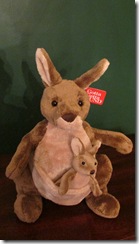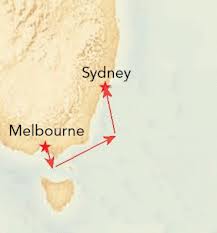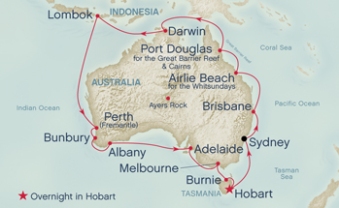Australia is located in the Southern Hemisphere between the Indian and Pacific Oceans. Australia is the smallest continent that is also a country and an island.
Once in the air, Granby and Henry will fly 35 hours, 35 minutes (including time for layovers in Los Angeles, California and Sydney, Australia) and 10,059 miles from their home in the United States to Melbourne, Australia.
Because Australia is in the Southern Hemisphere, the seasons are opposite of how they are in the United States. Summer is generally December, January, and February. Autumn is March, April, and May, Winter is June, July, and August. Spring is September, October, and November. The southern eastern region of Australia has a temperate climate with warm to hot summers and mild winters. Rainfall is spread throughout the year. The northern part of Australia is closer to the Equator and has a tropical climate with a wet season in summer and autumn with heavy rainfalls, and a dry season in the winter and spring that has sunny and humid days.
Deserts cover much of central and northwestern Australia while snow can fall in the mountains of southeastern Australia and Tasmania.
The Commonwealth of Australia consists of six States and two Territories. The largest State, Western Australia, is about the same size as Western Europe. In size, Australia is the 6th largest country in the world after Russia, Canada, China, the United States of America and Brazil. Australia comprises 2.968 million square miles compared to 2.959 square miles in the 48 contiguous United States (excluding Alaska and Hawaii).
For its size, Australia has a relatively small population of 22,015,576 compared to the United States with a population of 313,847,465. Most Australians live in cities along its coastline. Sydney is the largest city with 4.429 million; Melbourne is second with 3.853 million; Brisbane is third with 1.97 million; Perth is fourth with 1.599 million; and Canberra, the capital only has a population of 384,000.
Currently, Melbourne, Australia is 16 hours ahead of the time in South Carolina because it is on daylight savings time which in Australia begins the first Sunday in October and ends the first Sunday in April. When Granby and Henry’s airplane lands in Melbourne, Australia at 11:20 am on Monday, March 11th, it will be 8:20 pm on Sunday, March 10th in South Carolina. We will only be 15 hours ahead of the time in South Carolina when we arrive in Australia because daylight savings time will begin in the United States on Sunday, March 10th. While you will “spring forward” one hour at 2:00 am on March 10th, Granby and Henry will be springing forward 16 hours!
Not all the states in Australia observe daylight savings time. Without considering daylight savings time, Australia has three time zones with Perth on the west coast being two hours behind Sydney on the east coast.
The government in Australia is both a federal parliamentary democracy and a constitutional monarchy. Queen Elizabeth II of England is the official Chief of State. On the recommendation of the Prime Minister, the Queen appoints a Governor General as her representative. The Prime Minister is the leader of the majority party or leader of the majority coalition as determined by popular election. The current Governor General representing the Queen as Chief of State is Quentin Bryce. The Prime Minister is Julia Eileen Gillard. The legislative branch of government is a bicameral Federal Parliament consisting of an elected Senate and a House of Representatives.
The Aboriginal people arrived in Australia about 40,000 years ago. In the early 1600s, the Dutch sailed to Australia and made maps of the west coast and the northern coastline. In 1770, Captain Cook, an explorer from England, sailed along the east coast of Australia and named it New South Wales. On January 26, 1788, the British First Fleet landed at Sydney Cove and established the first European settlement in Australia. This date is now celebrated annually as Australia Day, a national holiday to commemorate the founding of Australia.
Until 1901 the Commonwealth of Australia used Britain’s flag, the Union Jack. Today, Australia’s flag has the Union Jack in the top left corner. This shows that Australia is part of the British Commonwealth. Beneath the Union Jack is a large white star with seven points. The points represent the six states and the territories. Originally this star had six points. The seventh point for the territories was added in 1908. On the right hand side are the stars of the Southern Cross. The Southern Cross was chosen because it can always be seen in the Australian sky at night.
 Before starting a two month long journey with Granby and Henry, Roo and her joey visited granddaughter Lindsay who helped Roo to name her joey. Roo’s baby girl now has the name Ester, a name that means Star. Lindsay will be following Roo and Ester’s travels in Australia and New Zealand during March and April.
Before starting a two month long journey with Granby and Henry, Roo and her joey visited granddaughter Lindsay who helped Roo to name her joey. Roo’s baby girl now has the name Ester, a name that means Star. Lindsay will be following Roo and Ester’s travels in Australia and New Zealand during March and April.



